|
FAQs about Non-Vertebrate Animal Identification
39
Related Articles: Marine Invertebrates, Marine Invertebrate Systems, Marine Invertebrate Compatibility,
Marine Invertebrate Disease,
Marine Invertebrate
Reproduction, Quarantine of Corals and
Invertebrates, Feeding
Reef Invertebrates, Lighting
Marine Invertebrates, Water Flow, How Much
is Enough,
Related FAQs: Non-Vert IDs 1, Non-Vert IDs 2, Non-Vert IDs 3, Non-Vert IDs 4, Non-Vert IDs 5, Non-Vert IDs 6, Non-Vert IDs 7, Non-Vert IDs 8, Non-Vert IDs 9, Non-Vert IDs 10, Non-Vert IDs 11, Non-Vert IDs 12, Non-Vert IDs 13, Non-Vert IDs 14, Non-Vert IDs 15, Non-Vert IDs 16, Non-Vert IDs 17, Non-Vert IDs 18, Non-Vert. ID 19, Non-Vert. ID 20, Non-Vert. ID 21, Non-Vert. ID 22, Non-Vert. ID 23, Non-Vert. ID 25, Non-Vert ID 26, Non-Vert ID 27, Non-Vert ID 28, Non-Vert ID 29, Non-Vert ID 30, Non-Vert ID 31, Non-Vert ID 32, Non-Vert 33, Non-Vert ID 34 Non-Vert ID 35, Non-Vert ID 36, Non-Vert ID 37, Non-Vert ID 38, Non-Vert ID 40, Non-Vert ID 41, Non-Vert ID 42, Non-Vert ID 43, Non-Vert ID 44, Non-Vert ID 45, Non-Vert ID 46, Non-Vert ID 47, Non-Vert ID 48, Non-Vert ID 49, Non-Vert ID 50, Non-Vert ID 51, Non-Vert ID 52, Non-Vert ID 53, Non-Vert ID 54, Non-Vert ID 55, Non-Vert ID 56,
Non-Vert ID
57, Non-Vert ID 58,
Non-Vert ID 59,
Non-Vert ID 60, Non-Vert ID 61,
& Marine Invertebrates, Marine Invert.s 2, Marine Invert.s 3, & FAQs about:
Marine Invertebrate Behavior,
Marine Invertebrate
Compatibility, Marine
Invertebrate Selection, Marine
Invertebrate Systems, Feeding
Reef Invertebrates, Marine
Invertebrate Disease, Marine
Invertebrate Reproduction, &
& LR
Life Identification, LR
Hitchhiker ID 1, Anemone
Identification, Aiptasia
Identification, Aiptasia ID 2,
Worm Identification, Tubeworm ID, Polychaete Identification, Snail Identification, Marine Crab
Identification, Marine Invert.s 1,
Marine Invert.s 2, Marine Plankton,
|
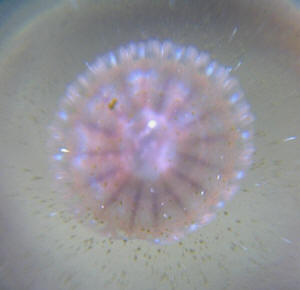
|
|
Tired of Nerite Eggs, or Whatever They Are:
Foraminiferans - 9/15/08 Hi Crew, <Hi Tom, Lynn here
today.> About six months ago you ID'd these calcareous
discs as Nerite egg casings, thank you for that. <On
Mich's behalf, you're very welcome! She's a real gem
when it comes to ID's! I just took a look at your original
photo (at this link: http://www.wetwebmedia.com/snailidfaq6.htm)
and those do indeed look like Nerite egg capsules. Had I answered
your query, I would have given the same answer. However, after
looking at your new photo, I'm thinking that you might have
something else entirely, specifically Foraminiferans. Nerite
capsules are sesame seed shaped, a bit 'pillowed' (not
flat), usually a uniform opaque white, fairly consistent in size,
and are adhered fairly well to whatever surface they're on.
See the photo at this link under the query titled 'What Is
This!?! Nerite Snail Egg Capsules 9/10/07' for comparison:
http://www.wetwebmedia.com/snailid12.htm What I see in your photo
(after enlarging it quite a bit), are objects that look thin,
wafer-like/more discoid in shape, vary considerably in size, and
appear to be loosely arranged on top of the rockwork/algae.
I'd love to see an extreme close-up of one, but it would
understandably be difficult to achieve. For more information on
Foraminifera, please see the query titled 'ID Help:
Foraminiferan, Likely Marginopora sp. - 4/21/08' at this
link: http://www.wetwebmedia.com/invertid34.htm . Here's a
terrific article as well, with photos:
http://www.reefkeeping.com/issues/2003-07/rs/index.php .> I
understand they're harmless and all, but I would really like
to get rid of them. <Foraminiferans are indeed harmless, even
beneficial. Personally, I'd leave them but if you'd like
to reduce their numbers, there are some predators Dr. Shimek
mentioned (in his article listed above) that may consume them.
They include hermits, various sand sifting fishes (if the forams
you have also inhabit the substrate), and bristleworms. Mind you,
none of these creatures feed solely on forams. They may have
other preferred foods they consume first before going after
these. Another option you might try is suctioning them out. You
could knock them loose with something like an algae scraper, then
vacuum.> Would you have any suggestions? Anything that will
eat/kill/slow these things down (either the eggs, adult snails,
or both). <See above.> I've tried scrubbing them off
the rock but they eventually reappear... <I'd opt for
diligent vacuuming, possible introduction of a predator.> ..in
all this time I haven't seen a single adult snail.
<That's understandable!> Thanks, Tom
<You're very welcome Tom, and good luck! --Lynn>
|
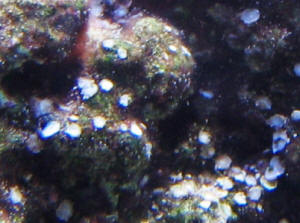 |
| Re: Tired of Nerite Eggs, or Whatever
They Are: Foraminiferans - 9/15/08 Hi Lynn, <Hi
Tom!> Thank you very much for this ID...you seem to have nailed
it. <Yay!> I Googled better pictures at:
http://www.poppe-images.com/images/image_info.php?picid=910670
http://www.poppe-images.com/images/image_info.php?picid=907142
http://www.cushmanfoundation.org/resources/slides/forams.html (the
third one down looks exactly like mine) <Excellent. Yep,
it's a common tropical species in the genus Marginopora that
can get surprisingly large. Many forams are very small indeed
(<2mm). They're odd, but neat looking little things,
aren't they!> I used to have a few (40-50) hermits in this
tank, mostly Clibanarius tricolor and kin. They eventually consumed
each other <Typical> or otherwise died out, now that I think
about it, this may have been just a few months before these discs
started to show up...now it seems this was no coincidence.
<Wouldn't surprise me a bit. While the crabs are away, the
forams will..run amok - wheee!> I think I'll do some crab
shopping. <LOL This time, maybe start off with just a couple and
see how they do. That way, maybe you can end up with a healthy
balance of each.> Tom <Take care, -Lynn> |
|
Strange Snail: Young Astraea -- 9/15/08
<Hi there, Mitch> I keep finding these in my reef at
home....(not the quarter now) <Heheee!> never see them on
corals, but always on glass. <Yes, that's typical.
They're herbivorous grazers that pose no threat to corals and
seem to prefer hard surfaces (glass/rockwork/equipment).> My
turbo snails are always having babies, <Hmmm, I'm
wondering if you aren't perhaps seeing Collonista snails, aka
'Mini Turbos' (very common/beneficial little
hitchhikers). If what you have are the typical 'Turbo
grazers' sold through most LFS, those are broadcast-spawners
whose young have very little chance of survival in most home
systems. Please see this link for comparison/more information:
http://bb.wetwebmedia.com/viewtopic.php?f=25&t=242 >
..could these be small Astraea? <Yes, that's exactly what
they look like. Please see this link for more information (see
second photo down for comparison):
http://bb.wetwebmedia.com/viewtopic.php?f=25&t=375 >
Please let me know.... mixed sps/high dollar LPSs reef. Thanks,
Mitch <You're very welcome. Take care, -Lynn>
Re: Strange Snail: Young Astraea -- 9/15/08
Hello, my name is Mitch <Hello again, Mitch> ..and I sent a
picture txt message from my phone to you guys a minute ago. My
comp is not working so I wasn't sure if you would get the
message from earlier. <Yes, we got it just fine, thanks.>
If you could reply in regards to the picture to this email, I
would be thankful. Thanks, Mitch p.s.the pic was about snails in
my reef <Got it. You're very welcome. Take care,
-Lynn>
|
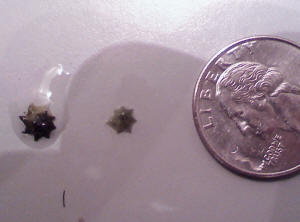 |
|
What's on my Halimeda?
8/21/08 Good evening Crew! I was checking out my tank tonight
and noticed that my Halimeda algae has something wacky covering
the blades. See attached pics. These were not there last night.
Any idea what this is? Thanks as always. Andy <Mmm, would
really like to see this under magnification... Am guessing that
due to its upright structure, repeated appearance, that this is
some sort of Hydrozoan. Do you have access to a sort of
dissection microscope with a camera? Bob Fenner>
|
|
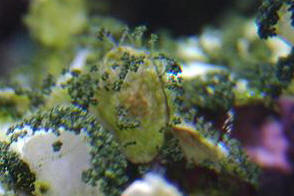
What's on my Halimeda? 8/22/08 A
dissection microscope? That sounds fancy. I have some binoculars
and a pirate's telescope made for a 3 year old, but I
feel that neither of those will work. <Mmm, just the QX
scope... even I have/use one> All growths are gone 24 hours
later . . . <Bizarre!> I guess I will research whether
hydrozoans are bad . . . <Can be if too numerous, the system
small...> Thanks for your insight. Andy <Happy to share.
BobF>
|
|
Need Help 08/12/2008 Wet Web Media Crew - <<Hi
there>> I was hoping you could help identify what is in the
attached picture.? I have a 60 gallon hex tank? as well as a 90
gallon corner tank.? Both are? salt water and non reef tanks.?
This sponge like substance is in both tanks.? It grows in my
filter and low light areas.? Do you know what this is and how I
can get rid of it?? Any information would be appreciated. Thanks.
Jim <<Please re-send with the mentioned picture, attached.
Thanks. A Nixon>>
Re: Need Help... ID 08/14/2008 Sorry... I thought the
picture was attached.? I hope you can see this one clearly.
<<he he he.. Its fine, received the pic now. Just common
sponges which are found in near enough all our home aquariums.
Simple filter feeders which cause no harm, and will grow with
nutrient levels. If you dislike them, then yes, feel free to
remove them, however, be prepared for a constant battle as
sponges will soon grow back.>> <<Thanks for the
questions, hope this helps. A Nixon>>
|
|
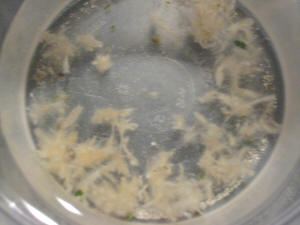
|
| Yellow "squiggly" slime?? what's
that!? 8/7/08 Hi again...you guys helped
before...thought this was interesting (@ least for me) to send
along. Wondering what you think this may be.....pls see attached
pic. Just noticed it today when I got home. It's in two areas..
Another just below and to the left. more in the corner of tank. 30
gal reef tank turbo snails sand sifting snails narcassis snails and
fishies <Mmm, snail eggs... see WWM re IDs of such:
http://wetwebmedia.com/snailid9.htm and the linked files above...
Sing it uhh! BobF> |
|
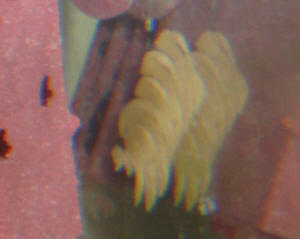
|
Polychaete worm photo... Chiton 8/5/08
Hello, ????????? <Mich with you today.> Thanks for the
awesome service you provide to reef keepers everywhere. <On
behalf of Bob and the crew, you're welcome!> I have had my
125 gallon reef setup for about 5 years now. <Very nice!> One
on my favorite things to do in the evening is to see what I can
find among my live rock, <Heehee! Mine too!> well I found a
strange looking worm. It is about 3/4 of and inch wide and am not
sure how long it is. I have watched it extend about 4 inches from
the rock without ever revealing its end. Attached is a picture of
the head or front of it. I appears to have a pink triangle-shape on
its head and its body is black and green. I hope you can help me
identify this worm. <It is a Chiton.> I know its not harmful,
<You are correct.> I just want to learn more. <Glad to
hear! Something to start you! http://en.wikipedia.org/wiki/Chiton
http://home.inreach.com/burghart/ > I have scoured the Internet
and nothing looks similar. <Heehee! Hard to learn about what you
can't ID, eh? The picture I attached is of the top of its head.
Thanks <Welcome! Enjoy your newly identified friend! Cheers,
Mich> |
|
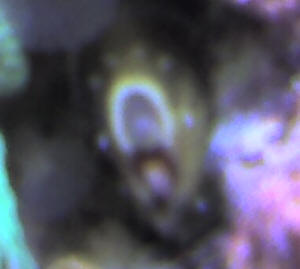
|
| Mysterious Sponge? 7/29/08 Hi
WWM Crew, <Rob> Once again, I've found myself at a loss
as to the identity of this newest addition to my reef. It's a
white puffy sponge-like growth that's formed on the underside
of my LR in several locations. <I see it/this> They look
kinda like a cigarette filter without the paper (if that makes
sense). I'm attaching a picture for reference. As always, your
expertise in identifying this as well as removal method is greatly
appreciated. You guys ROCK ! Respectfully, Rob <I would leave
this sponge as it is... testimony to your good husbandry. Bob
Fenner> |
|
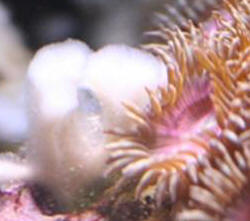
|
White Pods Growth in Refugium Chaeto Algae...
Syconoid Sponges 07/20/2008 Hi All, <Hi Chris, Mich here
today.> I am a long time fan and reader of your website and
thought you might be able to help identify what is growing in my
refugium. <Hope so!> There are white pod like growths mingled
throughout my Chaeto algae. The refugium is light by a power
compact light and contains Fiji miracle mud and a couple of clams.
<Really? Clams in your refugium? Are they doing well? I'm
surprised they are getting enough light.> At first glance we
thought it might be copepod eggs. <Nope.> We are worried if
this is something we should remove from our tank or if the white
pods are beneficial. <They are Syconoid sponges, harmless filter
feeders. Nothing to be worried about. The population generally
waxes and wanes. You can see similar ones here:
http://www.wetwebmedia.com/spgidf7.htm
http://www.wetwebmedia.com/spgidf6.htm
http://www.wetwebmedia.com/spgidf5.htm
http://www.wetwebmedia.com/spongeidfaq3.htm
http://www.wetwebmedia.com/spongeidfaq2.htm Attached is a picture
of the growth. <Got it.>
Thanks,
Chris
<Welcome,
Mich> |
|
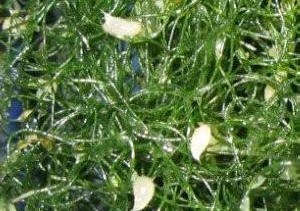
Re: White Pods Growth in Refugium Chaeto Algae
7/20/08White Pods Growth in Refugium Chaeto Algae...
Syconoid Sponges Thank you very much for the answer. <You
are most welcome Chris.> By the way don't worry about the
clams they are tiny hitchhikers smaller pinky nail not large
ones. <Glad to hear they are not Tridacnid. Enjoy your
sponges!> Regards, Chris <Cheers, Mich>
|
Live Rock Hitchhikers! 7/18/08 Hello Crew, I am a
somewhat experienced saltwater enthusiast, having about 1 year of
experience with a 55 reef setup. This year was spent with at least 5-10
hours per week spent reading and researching throughout the entire
year.. so it's more than just a 'casual' "hey
let's throw some fish and corals in a tank" kind of
experience... Anyway... I just started a Nano tank, for the
"challenge" of it. After patiently waiting until the water
parameters were stable, I bought myself a nice 3 lb piece of live rock
at the LFS. After a few hours, I was looking at the tank and making
some observations, and I saw a few neat creatures that I had not seen
at the store: a smaller feather duster, some random smaller zoanthid
type polyps (hopefully not aiptasia, but they have a deep body, so
I'm thinking they're not) And I thought that was all really
neat. However, I was looking at the back part of the rock, and it
looked like something large moved! Turns out, I have some sort of clam
that attached to the rock and is covered in beautiful coralline algae
and some macroalgae. All the research I've done about clams has
been the Crocea and Maxima varieties, but this one has the body shape
of a freshwater "eating type" (I hope my descriptions make
sense..) Any ideas on this guy? I have about 3.5 watts per gallon
lighting and the tank is only a 10 gallon, so I'm not sure what
I'll do with this hitch hiker, besides research of course. Thanks
for the much appreciated help and suggestions/insight. Eric <Hello
Eric. Bivalves -- clam, oysters, scallops, and mussels -- are very
diverse, with literally thousands of species known to science. Most are
marine, fairly small, and infaunal, meaning they live in sand, soft
rock or sunken wood. So from your description it is virtually
impossible to put a name to what you have! But you could start here,
and see if anything rings a bell...
http://www.wetwebmedia.com/bivalvia.htm That said, virtually none will
do any harm in an aquarium, so identifying them usually isn't
critical. The main problem with bivalves is that the majority are
filter feeders (a few are micropredators or deposit feeders) so the
bigger species often find it hard going in the largely plankton-free
aquarium environment. If they die from starvation, you have a lump of
rotting protein there messing up your water quality. But small
"hitchhiker" species may well survive, even thrive, without
undue fuss. What you're actually learning about is that marine
invertebrate diversity is an order of magnitude (at least) greater than
freshwater invertebrate diversity. Every piece of living rock will have
representatives of at least half a dozen animal phyla, including ones
you never see in freshwater, such as the Echinodermata and Sipunculida.
So, enjoy your new "pets", go grab a book on marine
invertebrates, and learn about the wonders of marine biology! Cheers,
Neale.>
|
What's in the tank? Hair or Spaghetti worm -- 7/16/08
Hello all! <Hi Kathy!> Once again I am in need of a
question answered... I have a 55 gallon saltwater tank. In
January I purchased 65lbs of live rock. For the last 7 months I
have been totally fascinated with the little creatures that are
emerging. <It's the gift that keeps on giving, isn't
it!> Yesterday I noticed what looked to me like long pieces of
hair on the bottom, across the crushed coral substrate. I have
long black hair so I thought some of it had gotten in the
tank...but when I looked closer it was thread-like, dark and
light alternating along the "thread" and it was
moving!! Then I notice 3 or 4 more! All seemed to be stretching
out from under a piece of the LR...and this morning when I fed
the fish, these "threads" seemed to attach to the blood
worms and mysis shrimp I had put in. They stretch out
approximately 6 to 8 inches... in different directions. I've
spent most of the morning reading and trying to identify, but I
can't wait. My eyes are blurry and I have to know,
"What's in my tank?" Can you give me a clue as to
what this is so that I can begin, in a logical place, to look on
the website, to research this little creature? <It sounds a
lot like a harmless/beneficial Hair worm/Cirratulid (Family
Cirratulidae), or possibly a Spaghetti worm/Terebellid (Family
Terebellidae). Both are deposit/detritus feeders, as well as
scavengers that make nice additions to a system. For more
information and photos, please see the following links:
http://forum.marinedepot.com/Topic34114-11-3.aspx (last post on
the page) See the Query 'Red worms with black Rings?
7/8/07' at this WWM link:
http://www.wetwebmedia.com/wormidfaq10.htm
http://www.reefkeeping.com/issues/2002-06/rs/index.php > OBTW
I love, love, love, your website! <Thank you, thank you, thank
you!> So much so that some days it's hard to do my
work...mind and body keep drifting back to the PC :) <Heheee!
I know the feeling!> Thanks so much, tootles, ~Kathy
<You're very welcome, Kathy. Take care, -Lynn>
Re: What's in the tank? Hair or Spaghetti worm --
7/17/08 <Hi Kathy> Well...creepy looking things.. but,
I will keep them around, the more I watch them the more
fascinating they are! <Indeed they are!> (I found a couple
more :) ) thanks again! Tootles, ~Kathy <It was a pleasure!
Take care, -Lynn>
|
| What is it? Got tons of them in a tank with
base rock, crabs, snails, and two clownfish...nothing
else...appeared overnight....they are 1/4 inch and smaller.
<Look to be small sea cucumbers... a better resolved pic will
get you a better guess. Bob Fenner> |
|
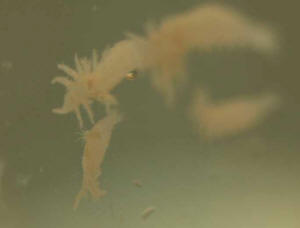
|
Sponge ID... uhh, worse 7/6/08 Hi Bob
and Crew, Can you help us identify this thing (we think it's a
form of a sponge) growing from under our Goniopora. All of our
parameters have been good, we just noticed this one night when the
Goniopora had gone in. Picture is at:
http://photo.evasionoftruth.com/g1/aquarium/IMG_0849 cropped Its
directly in the center growing from under the frag disc. We are
wondering if we should remove it, it appears to be a filter feeder
as it does not retract when we touch it. <... is a Hydrozoan...
and is stinging the bejeesus out of the Poritid... needs to be
removed, scrubbed clean (with vacuuming if done underwater)
entirely. Please read here:
http://wetwebmedia.com/hyzoancompfaq.htm> Keep up the great work
on the site, we use it daily to find out things about having a reef
tank. Thanks, Buster
<Thank you for sharing Buster. Bob Fenner> |
|
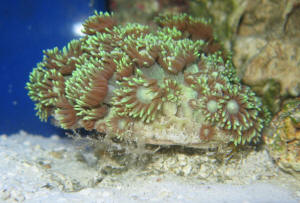 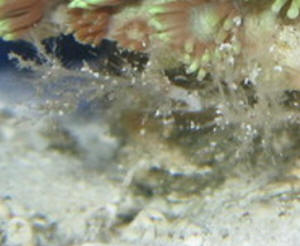
|
| worm or larvae identification? 7/4/08
Hello and thanks for all the great suggestions...your site is
extremely helpful! <Thanks> About 2 weeks ago, I've added
about 24 cerite, Nerite snails (hope I spelled them right) and
about 50 red-legged Mexican hermits to my 72 gallon bow-front reef
tank. Over the past week, I've notice maybe hundreds of tiny
white, thin dots on the back glass of the tank. I've never seen
these critters before and not sure if they are simply snail larvae
or harmful hitchhikers that came with the critters. I've taken
a few out just to observe them under a magnifying-glass and they
don't appear to any protrusions and/or any other physical
characteristics other than being flat, white, and smooth. I've
attached a photo as well. One observation, is that the snails
predominantly stay on the back glass where the concentration of
these white critters are. Thanks again for your help! Emmett
<Flat, white, smooth? Can you make a closer up, more resolved
image? These might be Limpets. Bob Fenner> |
|
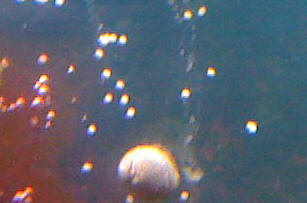
|
| Another New Critter - 7/2/08 Crew,
<Jared> I found another critter today that I have actually
seen before, but have never been able to get a good photo of. I
have a few of these in my tank, and they are either swimming or
attached to the glass. <Ah, yes! Was out for dinner at a friends
last night and they played some of the excellent "Blue
Planet" series... part of which featured some great footage of
strobilization...> They are about the size of a pea,
disc/umbrella shaped, and "pump" their bodies while they
swim AND when they are attached to the glass. I thought they were
some kind of jelly, but I haven't been able to find a picture.
The attached photo isn't the best, but I think you can get a
good idea. Thanks again, Jared S. <Is indeed a jelly... There is
but a small bit re their appearance, concern posted on WWM. Please
do relate further observations you have re. Bob Fenner> |
|

|
|
|

